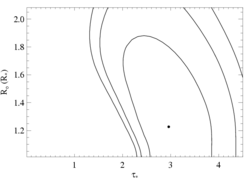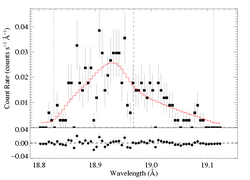O VIII 18.969 Angstroms
Non-porous models
Note: We fit only the MEG data. There are 246 MEG counts in the spectral region we fit (and plot below). See the fitting log. We also did some fitting experiments with just the m=-1 MEG data, and got very similar results.
Continuum fit on 18.70:18.80 and 19.12:19.30. View the spectral region near the line: MEG. For n=2, best-fit norm=2.40e-3. The 68% confidence limits on the normalization are +/- 8e-4. And the best fit is formally a good fit.
Here are the 68%, 90%, and 95% joint confidence limits on taustar and Ro. The filled circle represents the best-fit model, shown as the red histograms on the above plot.

|
Note that normal values of uo (~0.65)(note: that's Ro=1.5) are allowed at even the 68% confidence level. You can also compare this plot (5Jan09: well, the original version plotted with respect to uo) to an identical one but from fitting only the m=-1 grating arm. Excluding the m=+1 arm doesn't seem to make a difference (aside from making the confidence regions bigger), since the S/N is reduced.
Next, we fit isotropic porosity models to the data. And after that, anisotropic porosity models.
Back to main page.
last modified: 5 January 2009
